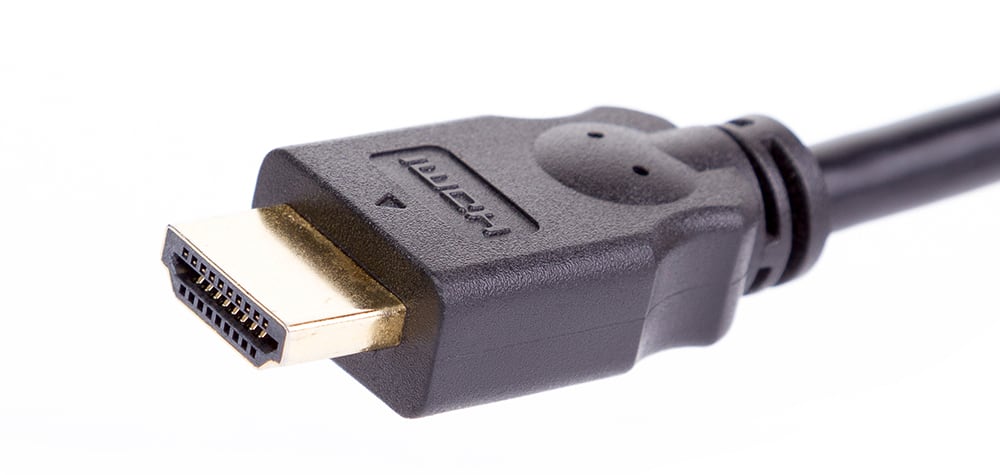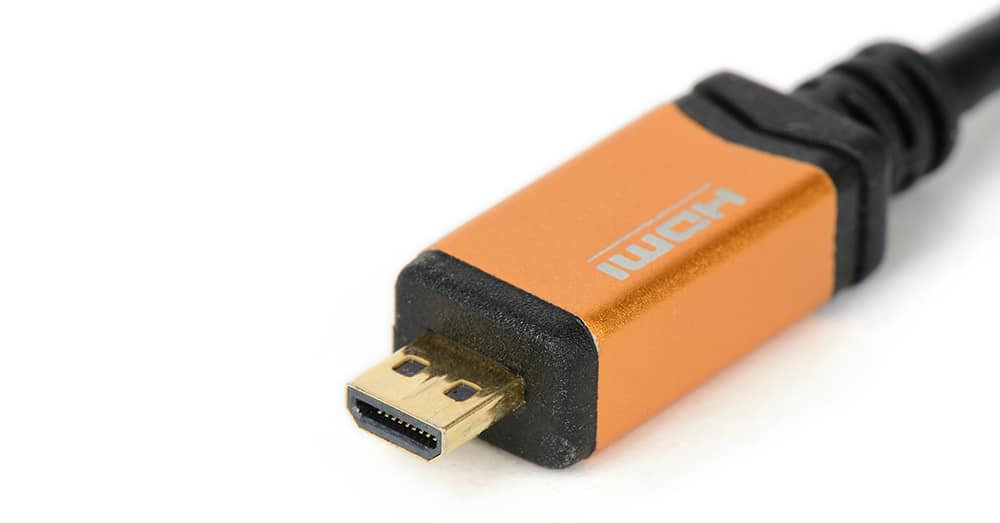An HDMI cable or High Definition Multimedia Interface is a type of connecting cable used to transfer audio and video files from one compliant device to another. For instance, from a display controller to a compatible computer monitor, digital television, video projector, or digital audio device.
Long-recognized as the acknowledged connection standard for transmitting uncompressed video data and compressed or uncompressed digital audio data.
The 5 sizes of HDMI are as follows:
Regardless of their size, all types except B, accommodate the default 19 pins.
There are 19 wires within a standard, mini, and micro-HDMI. Each wire connects to a pin at each end and is responsible for a specific task.
To list them all would be laborious as many are duplicated.
Several wires are dedicated to audio and visual streams, whilst there are at least two that are called clock channels. These are responsible for keeping all signals perfectly synchronized.
A further pin is used to monitor for power actuation when the device is turned on or off.
One 'channel' allows two devices to synchronize and control each other. For instance, it is courtesy of a specific pin in the HDMI lead that you can control the volume of the television via the remote for the cable box.
A further wire carries a 5v power supply. This enables the HDMI to supply the power for certain, usually small, devices.
Pin 14 is a "floater." This pin can be used for multiple different applications depending on the connected devices.
Note: All pins have designated numbers which are ardently adhered to throughout the industry.

Type-A is also known as a standard HDMI connector as it is the most widely used and readily available.
Born in 2002, to enable the high-speed transfer of high quality and bandwidth AV signals.
They make the connection of devices simple and are the flagship of the HMDI standard.
Their somewhat 'chunky' formfactor ensures they are robust and easily manageable.
They are found on almost all modern-day devices, such as televisions, desktop computers, monitors, and gaming consoles.
The male end, the plug, measures 13.9mm x 4.45mm.
The female end, the socket is marginally larger, measuring 14mm x 4.55mm.
To carry audio and video signals from various bandwidths, including basic standard definition, SDTV, EDTV, HDTV, to 4K UHD, Ultra-High Definition.
They are electronically compatible with single-link DVI-D (integrated digital and analog link).

Type-C is also known as mini- HDMI, although it still houses the same 19-pins in the same format as the standard size connector or Type-A.
Their reduced size makes them more compatible with smaller, more portable devices. They are usually found on DSLR cameras, camcorders, sat-navs, and large tablets.
The male plug measures 10.42mm x 2.42mm.
The mini-HDMI can do everything that its larger counterpart, the standard HDMI can do, it just has a more compact design.
The mini plug is regularly seen with a standard plug at the opposing end of the cable, however, other formations are available.

Type-D or micro-HDMI is, not surprisingly, the smallest of all three HDMI plugs.
Its compact size makes it the most portable of all plugs and therefore it is most commonly found on mobile phones. Although it still relies on the same 19-pins, their layout is modified due to size restrictions.
The male end measures 5.83mm x 2.20mm, making it less than half the size of the standard HDMI. It is of a similar size to a micro-USB connector.
It was developed specifically for audio and video transference in portable devices, such as mobile phones.
Type B was launched in 2002 along with standard HDMI. It utilizes 29 pins instead of the 19 that other designs rely on.
It carries a dual-link DVD-I but isn't used in modern-day products as technological and speed advances in the newest standard, HDMI 1.3, far out-pace it.
Type E is used for solely automotive purposes. It differs aesthetically as it has a cover to protect it from moisture and dirt. Whereas the other models simply push into position, the E-type has a locking tab, otherwise, vibration from the vehicle may encourage it to work loose.
If you're looking to set up a home theater, you should pay strict attention to the configuration of your HDMI-set up. It can significantly improve all audio and visual standards.
HDMI isn't just a cable, a connector, or a point. It is a series of guidelines transferred between 19 wires and pins, that ensures effective and efficient communication between two compatible electronic devices.
Standard-definition was the pre-cursor to Hi-Definition. You received an aspect ratio of 4:3, making an almost square picture with 704 x 480 pixels.
Modern-day HDTV has a rectangular picture with an aspect ratio of 16:9. It results in more pixels, 1920 x 1080, resulting in a wider screen, brighter, more colorful and clearer images, and a faster refresh rate.
All of this additional data required by HDTV calls for improved technology, which is where HDMI comes to the forefront.
HDMI uses transition minimized differential signaling (TMDS) to transfer information from one device to another. As a signal travels down a length of cable it is possible that it degrades and grows weaker, and more confused. TMDS is a coding system that ensures the signal is protected and remains complete throughout its journey.
For example, we'll use an HDMI connection between an HD-DVD player and an HDTV
Using HDMI can help prevent piracy. Every home theater device has a series of protocols that the receiving signal should meet, including identification and encryption data.
Once all criteria are passed, the signal can continue on its way.
This happens in the blink of an eye and is known as 'a handshake.'
Unfortunately, not all devices have caught up with technology and have HDMI connectivity yet.
Longer cords between connectors would be an advantage, particularly when connecting an entire system of devices. Longer cables present greater opportunity for signal degradation, although, this is something in production.
Within a home movie theater, the current standard suggests 1080p high-definition signals and supports 8 channels of uncompressed audio. That's enough to give perfect visuals and audio clarity when running 7.1 surround sound.
The optimum HDMI setup not only reduces the number of cables required to connect all devices but also decreases the number of remote controls you might need to operate everything successfully.
